Each year I explore photography techniques new to my skill set. The year 2011 was a High Dynamic Range (HDR) year.
Once I achieved a repeatable “look” in NIK HDR Pro, it was time to choose a subject. I decided to make photos of buildings in my home town familiar since childhood.
During post-processing I became obsessed with texture and definition. The ability to retrieve brilliant color from each and every pixel was fascinating. Think of all the color and detail our cameras are capable of! It’s amazing.
I compiled an HDR gallery, “A fresh look at olde town”, and below the gallery, you’ll find my HDR experience including the technique of HDR from camera to software.
THE VISION-Looking at a scene, we see something that compels us to fire the shutter. Our eyes witness the depth of highlights, shadows, mid tones, color, and detail yet loads of detail are missing when we view our images before post-processing.
Our eyes have a brain directing them, but our camera does not. My mind creates a feeling when I see, and as I make a photo in the computer, I’m able to create that perception for others to witness along with me. Visions become art.
EXPOSURE VALUE (EV) EXPLAINED-Exposure Value is the combination of shutter speed and lens aperture that incrementally allow the correct amount light in to expose a scene correctly. Most cameras have the ability to automatically vary the exposure away from the norm. Look in your camera manual for how to set up “bracketing” in your camera.
THE CAMERA-In order to realize the range of detail in highlights (- EV,) shadows (+ EV,) mid tones (0 EV,) the photography genius’ invented HDR processing software.
THE EXECUTION-Shoot various exposures of a scene and “stack” them in an HDR processing app.
THE ROUTINE
1. Shoot with a tripod and preferably a wired or wireless remote shutter release.
2. Continuous firing mode.
3. Use the auto setting that locks in your aperture. You don’t want to stack images with varying depths. Lens focus would also need to be the same for each shot in a series.
4. Bracket exposures in 1 EV increments.
Example: Shooting the same scene three times, you will take an exposure measuring + 1 EV, another at 0 EV, and one at -1 EV.
POST-PROCESSING
I process HDR’s with the NIK plug-in HDR Efx Pro™ through the host program Lightroom®. Having shot (5) bracketed exposures in (1) stop increments, and choose (3) to bring my vision alive.
Studying those (5) frames meant looking for detail in highlights, mid tones, and shadows. I only shoot 3 exposures now. I learned to shoot five only when the scene dramatically has highlights and shadows.
THE STEPS:
Select three the candidates. Look for detail in the highlights in one photo, mid tones in another, and shadows in yet another.
Using Adobe Lightroom:
Right click
Choose Export
Choose HDR Efx Pro™
The next screen to appear is not pictured here. (A software update added more options. If not sure of the terms here, just accept the defaults and move on.)
The next screen will produce an HDR image. You’ll find “recipes” on the left screen. Sliders to tweak the look on the right. This is where the magic happens. Try not to spend more than an hour here. Remember, you have lots more images waiting for you.
 Either choose a “recipe” (left)…
Either choose a “recipe” (left)…
 …or, begin editing with slider controls (right)
…or, begin editing with slider controls (right)
 When finished in NIK HDR Pro, choose SAVE, returning to Lightroom® you’ll see a TIF file was created with your HDR adjustments. Apply finishing touches, crop, and export.
When finished in NIK HDR Pro, choose SAVE, returning to Lightroom® you’ll see a TIF file was created with your HDR adjustments. Apply finishing touches, crop, and export.
EXPOSURE SAMPLES and RESULTS
ORCHARD BARN
 HDR RESULTS-This HDR doesn’t have the “look”. At the same time, it”s better than a straight, one exposure, image. Wordsmithing this site in 2018, Kim’s input? An HDR that doesn’t look HDR is the best HDR. Fantasy HDR are personally satisfying, but these days gave seemed to loose shock value. Maybe it’s time for a new twist to an old technique?
HDR RESULTS-This HDR doesn’t have the “look”. At the same time, it”s better than a straight, one exposure, image. Wordsmithing this site in 2018, Kim’s input? An HDR that doesn’t look HDR is the best HDR. Fantasy HDR are personally satisfying, but these days gave seemed to loose shock value. Maybe it’s time for a new twist to an old technique?
JOY SALES
WINDY SUNSET
EXTREME GREEN
Watch for halos: You can see them clearly here in “Uncle Chet’s Hats”
UNCLE CHET’S HATS
Halos are an undesirable aspects of HDR and easily avoided if you watch for them as you push the limits of detail and contrast.
Notice a glowing edge where the roof and sky meet (camera right) on Former Schmitt Motel. Halos can be seen. I had too much time invested in this image when I noticed it, so needed to corrected it in Photoshop® instead of processing it again. Although I couldn’t locate the finished photo, you’ll notice the roof line (between the chimney and roof peak has lost it’s glow and added realism. (Well, as real as an HDR extreme can look.)
FORMER SHCMITT MOTEL

In case you’re curious, below is the 0EV exposure
RAINS IN THE FOREST
One final note: Combining HDR and off-camera flash can be interesting.
If off-camera flash interests you, click for an Image Pixels Off-Camera Flash discussion
Thanks for sharing my HDR adventure.
Please post questions at the bottom of the page if you have them. Keep in mind, I’m no expert. I’m a photographer who chose to study HDR in 2011 and share my experience. Feedback on this tutorial helps me improve them in the future.
A FINAL NOTE: If I decide to creat a book of local neighborhoods, this photo already has it’s write up.
2011 North High School memory of 1976
Three shots were chosen from five bracketed exposures. The three exposures that made this HDR were (-2) (0) (+1).
North high school was updated many times, but this particular view of the building looks the same as it did in 1976; the year I graduated. Mechanic Arts Trades and Industry High School became North High School in 1956. But here it is, 2011, and a brand new school at a different location has been built. Students attending when this photo was taken, would return after Christmas break to their new school building.













































Kim….love your HDR shots….as you know…I am an HDR junkie!
LikeLiked by 1 person
Thank you Dan.I know your HDR work well, and love your extreme HDR! But then, when you use HDR for detail and depth only, your work is also fabulous. I’d love it if I could display one of your extreme HDRs here. The lighting control room of the Ford Center would be an excellent addition to this page.
LikeLike
Kim;
I like these, sometime maybe we can try this together? at times I really like the depth the photo takes on and a sort of oil painting look.
Thanks for the link, we’ll try this sometime.
Bill
LikeLiked by 1 person
It would be fun to shoot for HDR someday. Then, edit in LR & Nik HDR Pro Bill. Let’s make a plan for it.
LikeLike